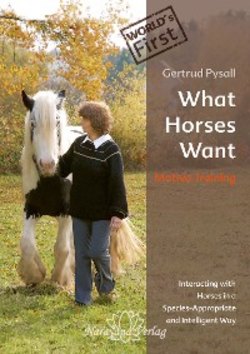Читать книгу What Horses Want - Gertrud Pysall - Страница 10
ОглавлениеIntroduction
What horses want or, phrased as a question: what do horses want? became my guiding principle for interacting with them. Previously, when I lived in Ellenberg, I used to observe our little herd of twelve animals often and very closely in order to discover the secret of what their needs really were. I wanted to understand their personal needs and how these are expressed in the herd, if and how these needs change over the course of the seasons and when new members join and old ones leave the herd.
Through intensive observation, numerous video recordings and studying these recordings in slow motion, I discovered the subtle signals horses give each other, which were repeated so many times that I recognised a pattern. This was activity, this was information. I began to understand. I had never read about this in any of my numerous books on horses. Others apparently had little or no knowledge of this information. After moving to Spenge I had even more opportunities to carry on with my research. Over time, we owned six herds of various compositions, 70 animals in total. This really improved the conditions for my research. I was able to film naturally occurring situations at all times as well as setting the stage for studying certain constellations. I analysed and catalogued these observations in uncounted hours.
In order to use my knowledge for the benefit of horses and to impart it to other people, I developed a method called Motiva, which was patented in Munich in 1996.
I became aware that horse herds are characterised by a very complex language and highly developed social behaviour which also includes a set hierarchy. Every horse knows his place in the hierarchy and this gives him security and certainty.
What is Motiva?
A society of horses is based on the interactions of individual animals. For this community to work, social rules are necessary. They guide interactions in the herd. Basically, they are very simple and robust rules that have been passed on and have stood the test of time. They can be expressed and enforced using the equine communication system. Both unilateral and reciprocal rights and obligations are passed down from older to younger herd members. Within the society of horses, it is hardly possible to ignore the authority of the lead animals. This authority establishes a natural order in the herd and ensures continuance of the social rules and of the entire herd, as well as the development of a sense of belonging.
Motiva teaches precisely these rules and relationships. It comprises knowledge about the social rules as such, as well as the highly developed modes of expression that horses use to convey, enforce and monitor these rules. Not only does Motiva teach humans to understand over 130 expressions of horses, but also how to use these expressions to speak with them. Motiva also trains people to recognise and resolve conflicts in a non-violent manner and to communicate effectively.
When we talk about “communicating with horses”, we must recognise that “understanding” is an integral part of “communication.” We need to gain a deep understanding of their nature, their social rules and rituals, their instinctive behaviour, their fears and decisions, their ways of life. The ability to speak and understand their language, informed by this complete body of knowledge, leads to the answer to our question: what horses want. And this clearly is the insight:
THEY WANT TO BE UNDERSTOOD.
Info
Motiva comprises knowledge about the social rules as such, as well as the highly developed modes of expression that horses use to convey, enforce and monitor these rules.
EQUINE EXPRESSIONS
When interacting with humans, horses always communicate. They cannot “not” communicate.
First tentative contact with a human
“I will guard you while you rest.”
Blowing softly into the nostrils as a sign of mutual friendship
Nuzzling as a gesture of friendship
The horse is blowing quietly to express contentment
Invitation for mutual scratching using his lips
Yawning as an appeasement gesture: “I do not want to invade your space”
Yawning is repeated to reinforce the previous statement
Checking for pheromones
Once more easing the situation by yawning
Shaking head, indicating that he does not want to offend the human (higher rank).
Info
Motiva teaches people to understand and communicate using over 130 equine expressions.
